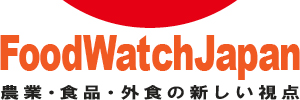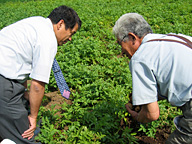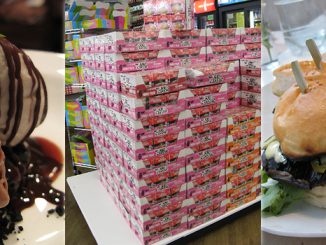
米国の食料品店では、スナック菓子や加糖シリアルなど様々な食品がそれらの栄養特性を表わすことを目的とする絵や数値があしらわれて販売されている。この表示は生産者側の任意表示であり、店頭表示と呼ばれるものの一つである。米国食品医薬品局(FDA)は、消費者や連邦議会議員から食品表示、特に「パッケージの前面」表示の内容についての問い合わせを受け、注意を払うようになった。パッケージ前面表示の新しいタイプの一つに「賢い選択プログラム」マークがある。このマーク、米国の食料品店の棚に並べられた食品に急増している。
Certain snack foods, sweetened cereals, and a variety of other food products are being marketed in U.S. grocery stores with pictorial or numerical images that are intended to represent nutritional attributes for the product. This labeling, which is voluntary on the part of producers, is part of what is called point of purchase labeling. FDA has taken notice after receiving questions from the public and Congressional representatives concerning the information on the food label, especially “front of package” labeling (FOP). One of the newest types of FOP is the “Smart Choices Program” logo that is proliferating on food products on America’s grocery shelves.
多様なシンボルがあり内容も多岐にわたること、そして統一の科学的基準を欠いていることから、FDAはパッケージ前面表示の調査を始めた。パッケージ前面表示の中には、その商品を違法たらしめる不正な表示があるのではとFDAは懸念している。FDAは、店頭での消費者向けの正確で正直かつ誤解を与えることのない栄養情報は、消費者が十分な情報を得たうえで選択する権利に資し、健康的な食生活を築く助けとなると考えている。FDAは、食品の栄養特性を示すための科学に基づいた統一の基準を模索中である。
包装販売する食品を扱う企業は、自社の製品を買ってもらおうと何とかして消費者の注意を引こうとする。食品の裏の表示には通常、原材料や栄養成分など必要とされる情報が記載されている。パッケージ前面表示や棚表示は、通常の表示に記載されている情報と一致していなければならず、また、その食品の性質を正確に表したものでなければならない。消費者が最初に見るのは商品の前面である。その格言が加えて言うように、一つの絵柄は多くを語る。ゆえに、健康に良い食品を求める多忙な買い物客に向けて、食品企業が彼らの製品の栄養的価値を手軽に伝える方法の一つとして、シンボルを多用するというのは驚くことではない。
結果として、様々なシンボルやグラフィック描写、画像や情報が製品の栄養的価値を伝えるためにパッケージの前面を飾ることになった。この問題は、様々な食品と食習慣、競合する利益に時に疑似科学もからみ複雑である。朝食用シリアルを例に取ってみよう。米国の食品メーカーは、子供向けの加糖シリアルを製造している。ある人が、子供たちが消費する砂糖の量を鑑みて、そのような食品は健康的といえるのかどうか疑わしいと言ったとする。するとまたある人が、朝食を食べる子供たちの方が学校の成績が良いという研究結果があるので、子供たちにアピールする食品を提供することは好ましいと主張する。
「賢い選択」プログラムは、食品メーカーが製品の栄養的価値をシンプルにかつ正確に訴求するための方法として考え出された。このプログラムのパッケージ前面の栄養表示には、「賢い選択」マークと一食当たりのカロリーそして一品当たり何食分かという表示が含まれている。「賢い選択」プログラムのホームページによると、このプログラムは、食品企業、学術研究機関、公衆衛生教育者、保健所、小売業界などの広範な連携のもとに作られた。
FDAや米国農務省(USDA)といった政府機関はオブザーバーではあったが、それを支持承認するということはなかった(米国政府にとっては標準的な慣習である)。「賢い選択」プログラムは、米国人のための食事指針に合致し、かつ健全な科学的基準に基づいたパッケージ前面の栄養表示の統一基準を作ることを意図されたものだ。そのプログラムによって、米国の食料品店の棚にパッケージ前面表示として、「賢い選択」マークやカロリー量が表示された製品が数多く並ぶようになった。
USDAとFDAが2009年8月に共同で出した文書に次のようなことが記されている。FDA及びUSDAは、「前面表示制度が誤解を招く恐れのある表示から消費者を保護する上で十分に厳しい基準に沿ったものでないとしたら、米国人のための食事指針と合致するだろうか、また、果物や野菜、全粒粉の代わりに高度に加工された食品や精製された穀物を消費者が選択することを奨励するような効果がないだろうか懸念せざるをえない」店頭表示に関する業界への指導通知の中で、FDAは、不正なあるいは誤解を招く恐れのあるパッケージ前面表示を擁する製品または表示規制に違反する製品に対して強制措置を取ると警告した。
一つには、FDAの懸念は独自の調査に基づいたものであった。その調査の結果とは、驚くことではないが、消費者はパッケージ前面に栄養表示があると、パッケージの後ろにある栄養情報を無視しがちになるというものである。例えば、「賢い選択」マークがあることによって、その製品の栄養価について後ろの表示に記載されているそのほかの栄養情報と一致しない印象を与えるとしたら、その製品は消費者に誤解を招く恐れがあり、従って違法となる。
さらに、FDAの規制では、栄養成分を表示するには、事前にFDAによる認可が義務付けられている。もしマークが、FDAの規制と一致しない栄養成分表示を意味していたならば、その製品は違法である。FDAが注目しているのは、「賢い選択」プログラムに限らない。望んでいるのは、現在あふれかえるほどある雑多な基準に基づいたパッケージ前面栄養成分表示を、健全な科学的指針に基づくより統一的なものに置き替えることである。FDAは、パッケージ前面表示の栄養基準を規定する規制案を作成中である。また、いろいろな食品表示の方法や消費者がその情報をどう捉えるかを引き続き調査していこうとしている。
FDAが今興味を示しているのが英国で開発されたプログラムである。英国政府は、任意のパッケージ前面栄養表示に対して信号機の色(赤・黄・緑)を用いた基準を設定した。食品中の脂肪(特に飽和脂肪)、塩分、加糖などのレベルがその三色によって示される。緑信号が多ければ、より健康的な食品ということになる。
日本では、機能性食品が長く受け入れられており、現行の規制では保健機能食品として特定保健用食品(トクホ)や栄養機能食品が定められている。また、これら二つの食品カテゴリー以外にも、カルシウムが強化されたクッキーであるとか健康増進を訴求する食品が数多く販売されている。健康増進を掲げる食品のカテゴリーは国によって異なる。とはいえ、健康的なライフスタイルのために考案された食品を消費者が欲しており、食品メーカーや政府当局もそれに応えるべく方法を模索しているのは同じだ。
日本について一つおもしろい話を聞いた。日本の高齢者は、今でも主として魚や野菜中心の伝統的な食事を取っており、健康食品を求めるということはどうもあまりないようだ。それではトクホや健康増進を掲げる食品の大きな購買層はというと、西洋型の食生活の影響で慢性疾患に罹りやすいといわれる第一次ベビーブーマーを含む若い世代であるという。
The variety of symbols and other information and a lack of uniform scientific criteria have compelled FDA to initiate a review of FOP labeling. FDA is concerned that some forms of FOP may misbrand a food product making it illegal. The agency believes accurate, truthful, and non-misleading nutritional information for consumers at point of purchase can help consumers make informed choices and construct healthy diets. FDA is interested in finding uniform, scientifically-based standards for representing nutritional attributes of food products.
Firms that market pre-packaged food products must compete for consumers’ attention to attract buyers. The back panel of a food label usually contains required information such as the list of ingredients and important nutrients. FOP labeling and shelf labeling must be consistent with the other information provided in labeling and must accurately represent the nature of the product. It’s what’s up front that consumers see first. As the adage says a picture tells a thousand words. So it is not surprising that as busy shoppers seek more healthful food products, food manufacturers look to symbols as a way to conveniently convey the nutritional value of their products.
Consequently, various symbols, graphic representations, and other images and information are being used in FOP labeling to convey the nutritional value of a product. The issue is complicated by a diverse food products and dietary habits, competing interests, and sometimes equivocal science. Take breakfast cereal for example. Food manufactures in the U.S. produce sweetened cereals designed for children. Some question whether such foods can be considered healthful in view of the amount of sugar that children may consume. Others assert that because studies have shown that children who eat breakfast perform better in school it is better to offer foods that appeal to them.
The Smart Choices program is meant to provide a simple, accurate way for food manufacturers to indicate the nutritional value of food products. The program’s FOP nutrition label includes a Smart Choices logo and caloric numbers indicating the caloric content per serving and the number of servings per package. According to its homepage, the program was developed by a broad coalition from food industry, academia, public health educators, public health organizations, retailers, and others.
Government agencies such as FDA and USDA were observers but did not endorse the program (standard practice for the U.S. government is such circumstances). The program is intended to provide a uniform standard for FOP nutrition labeling that is based on sound scientific criteria consistent with the Dietary Guidelines for Americans. The Smart Choices program has led to a proliferation of food products on American grocery shelves that bear its logo and caloric numbers as FOP labeling.
A joint August 2009 letter from USDA and FDA to the Smart Choices Program stated that FDA and USDA “would be concerned if any FOP labeling systems used criteria that were not stringent enough to protect consumers against misleading claims; were inconsistent with the Dietary Guidelines for Americans; or had the effect of encouraging consumers to choose highly processed foods and refined grains instead of fruits, vegetables, and whole grains.” In a Guidance for Industry letter regarding point of purchase food labeling, FDA cautioned that FDA will proceed with enforcement action against products that bear false or misleading FOP labeling or that otherwise violate the labeling regulations.
In part, FDA’s concern is based on its own research that has shown, not surprisingly, that when FOP nutrition labeling is used, consumers tend to ignore the nutrition information provided on the back of the package. If the use of the logo, for example, creates an impression about the nutritional value of the product that is not consistent with other nutritional information provided on the label, the product may mislead the consumer, and thus be illegal.
Further, FDA regulations require that nutrient content claims be approved by FDA before they are used. If the logo suggests a nutrient content claim that is not consistent with FDA regulations, the product could be illegal. FDA’s attention is not limited to the Smart Choices program. The agency wants the current plethora of nutrition FOP labeling that is based on varying criteria replaced by a more uniform approach based on sound scientific principles. FDA is developing a proposed regulation to define nutritional criteria for FOP labeling, and FDA intends to continue to evaluate various food labeling approaches and how consumers view the information.
FDA is interested in a program developed in the United Kingdom whereby the government set criteria for voluntary nutrition FOP labeling using traffic light colors (red, yellow, and green) to indicate levels of fat (especially saturated fat), salt, and added sugar a food contains. The more green lights, the more healthful the food.
In Japan, functional foods have a long history of acceptance and current regulations define broad categories of “Food for Special Health Uses” (FOSHU) and “Food with Nutrient Functional Claims” (FNFC). In addition, there are many food products in Japan that fall outside of the defined FOSHU and FNFC categories that have attributes purported to enhance health, such as calcium-enriched cookies. Categories of foods that have health-enhanced claims or information vary among countries. However, it is clear that food manufacturers and government authorities are seeking ways to respond to consumers’ increasing desire for foods designed for health lifestyles.
One interesting note regarding Japan is that the older population still relies primarily on the traditional diet of fish and vegetables and is not so likely to seek health-enhanced foods. Whereas, the younger generation, including the “baby boomers,” who are becoming increasingly dependent on a Western diet and thus more susceptible to chronic disease, are more likely to be attracted to foods with the FOSHU designation or other health-enhancing foods.
※このコラムは「FoodScience」(日経BP社)で発表され、同サイト閉鎖後に筆者の了解を得て「FoodWatchJapan」で無償公開しているものです。




